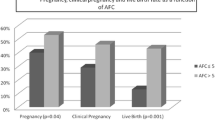Abstract
Background
The relationship between elevated basal FSH and embryo quality remains a topic of heated discussion among practitioners of ART. Some authors suggest a negative effect of raised FSH on the quality of embryos and therefore on IVF treatment outcome. We postulate that women with elevated FSH who respond well to ovarian stimulation and have embryos to transfer, have the same chance of conceiving like women of a similar age with normal FSH. To test this hypothesis, we studied women with elevated basal FSH who made enough embryos to qualify for blastocyst culture and day 5 embryo transfer.
Methods
Analysis of data collected prospectively, on women age 25–43 years, who underwent IVF between January 2005 and December 2006. The women were divided into: those with high FSH (≥10 IU/L) and women with normal FSH (<10 IU/L). We analysed data to show treatment outcome in the two groups, following embryo transfer on day 3 and after transfer on day 5. Outcome measures include number of oocytes retrieved, number of embryos available, implantation rate, pregnancy and live birth rate.
Results
Among the 1,858 women who under-went a day 3 transfer, 1,368 had basal FSH ≤ 10 IU/L, and in 492 basal FSH was above 10 IU/L. The average number of oocytes retrieved was lower among women with elevated FSH (10.12 ± 5.6 Vs 6.16 ± 3.9). Women with a normal FSH, had a higher pregnant and live birth rate than those with elevated FSH (43.3% vs 27.9% p = 0.021) and (30.8% vs 17.6% p = 0.028) respectively. 398 women made enough embryos to qualify for extended embryo culture to blastocysts. Of these 366 had an FSH ≤ 10 IU/L and 32 had FSH > 10 IU/L. In this group, there was no significant difference in the pregnancy and live birth rates between women with elevated and those with normal FSH, (67.2% vs 65.6%) and (51.9% vs 43.8%) respectively. In this selected group of women where quantity is not an issue, the quality of embryos was same irrespective of whether the basal FSH was low or high.
Conclusion
Women with elevated basal FSH who respond well to stimulation and generate a good number of oocytes / embryos have a chance of becoming pregnant and having a live birth similar to that of women of their age. Women should therefore not be denied the benefits of IVF based solely on the basal FSH level as a subset may respond well and therefore have a good chance of taking home a baby.
Similar content being viewed by others
References
Scott RT Jr, Hofmann GE. Prognostic assessment of ovarian reserve. Fertil Steril. 1995;63:1–11.
Balasch L, Creus M, Fabregues F, Carmona F, Casamitjana R, Ascoso C, et al. Inhibin, follicle-stimulating hormone, and age as predictors of ovarian response in in-vitro fertilisation cycles stimulated with gonadotrophin-releasing hormone agonist-gonadotrophin treatment. Am J Obstet Gynecol. 1996;175:1226–30. doi:10.1016/S0002-9378(96)70032-7.
Barnhart K, Osherof J. Follicle stimulating hormone as a predictor of fertility. Curr Opin Obstet Gynecol. 1998;10:227–32. doi:10.1097/00001703-199806000-00009.
Abdalla H, Thum MY. An elevated basal FSH reflects a quantitative rather than qualitative decline of the ovarian reserve. Hum Reprod. 2004;19(4):893–8. doi:10.1093/humrep/deh141.
Gardner DK, Schoolcraft WB. In vitro culture of human blastocysts. In: Jansen R, editor. Towards reproductive certainty: fertility and genetics beyond 1999. Canforth (UK): Parthenon; 1999.
Lenton EA, Sexton L, Lee S, Cooe ID. Progressive changes in LH and FSH and LH:FSHratio in women throughout reproductive life. Maturitas. 1988;10:35–43. doi:10.1016/0378-5122(88)90129-6.
Levi AJ, Raynault MF, Bergh PA, Drews MR, Miller BT, Sctt RT. Reproductive outcome in patients with diminished ovarian reserve. Fertil Steril. 2001;76:666–9. doi:10.1016/S0015-0282(01)02017-9.
Esposito MA, Coutifaris C, Barnhart KT. A moderately elevated day 3 FSH concentration has limited predictive value, especially in younger women. Hum Reprod. 2002;17:118–23. doi:10.1093/humrep/17.1.118.
van Rooij IAJ, Bansi L, Broekmans FJM, Looman C, Habbema J, te Velde ER. Women older than 40 years of age and those with elevated follicle-stimulating hormone levels differ in poor response rate and embryo quality in in vitro fertilisation. Fertil Steril. 2003;79:482–8. doi:10.1016/S0015-0282(02)04839-2.
Lambalk CB. Value of elevated follicle-stimulating hormone levels and the differential diagnosis during the diagnostic subfertility work-up. Fertil Steril. 2003;79:489–90. doi:10.1016/S0015-0282(02)04841-0.
El-Toukhy T, Khalaf Y, Hart R, Taylor A, Braude P. Young age does not protect against the adverse effects of reduced ovarian reserve–an eight year study. Hum Reprod. 2002;17:1519–24. doi:10.1093/humrep/17.6.1519.
Toner JP, Philput CB, Jones GS, Muasher SJ. Basal follicle stimulating hormone level is a batter predictor of in vitro fertilisation performance than age. Fertil Steril. 1991;55:789–91.
Thum MY, Abdalla H, Taylor D. Relationship between women's age and basal follicle-stimulating hormone levels with aneuploidy risk in in vitro fertilization treatment. Fertil Steril. 2007;2007(Oct):20. Epub ahead of print.
Author information
Authors and Affiliations
Corresponding author
Rights and permissions
About this article
Cite this article
Thum, M., Kalu, E. & Abdalla, H. Elevated basal FSH and embryo quality: lessons from extended culture embryos. J Assist Reprod Genet 26, 313–318 (2009). https://doi.org/10.1007/s10815-009-9313-y
Received:
Accepted:
Published:
Issue Date:
DOI: https://doi.org/10.1007/s10815-009-9313-y




